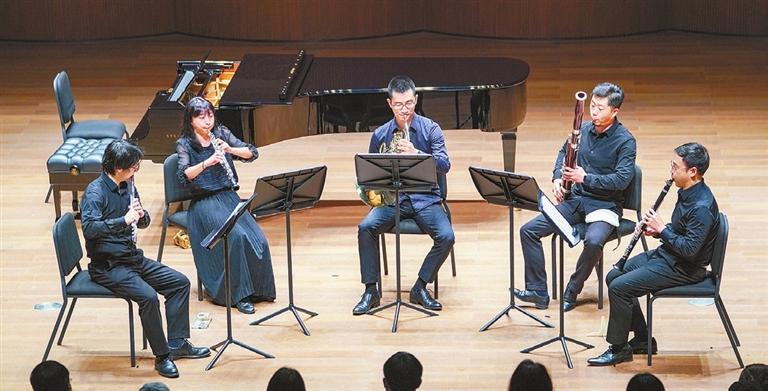
THIS Sunday evening, a wind quintet consisting of five musicians from the Shenzhen Symphony Orchestra (SZSO) will perform “The Magic Flute,” the final opera by classical master Wolfgang Amadeus Mozart. The ensemble includes flutist Qiao Yelu, oboist Yang Kaiting, clarinetist Zhang Feng, bassoonist Wang Bingchen, and French horn player Huang Jianan. They promise an unforgettable evening filled with dramatic and splendid music that represents the best of Mozart. Since the heyday of classical music when wind ensembles were most popular, French horns, which are actually a brass instrument, have always performed together with woodwinds. While the trumpet has long been a noble instrument associated with the court and the military, and the trombone has been seen as a sacred instrument for performing in churches, the horn has been the only brass instrument within reach of the common people. Since wind ensembles first took shape in an age when there was no clear sense of any distinction between woodwinds and brass, the combination of the horn with four woodwinds has come to be called a woodwind quintet. Traditionally known as the most challenging combination in chamber music, the woodwind quintet naturally has its unique charm, with a rich texture and splendid tone colors that cannot be achieved by other ensembles. While the story of “The Magic Flute” is a simple fairytale about a princess being rescued by a prince, it may even be a bit offensive to modern audiences with its strong implications for the teaching and practice of depending on wise male leaders in upholding society’s moral standards. That said, the two-act opera sung in the German language is a work beloved by classical music fans, thanks to its superb and colorful music. Mozart used varied musical styles to depict his characters. Folksy birdcatcher Papageno and his late-appearing sweetheart, Papagena (the names derive from the German word for “parrot”), are given unpretentious, folk music-style melodies. By contrast, the deceptive Queen of the Night is portrayed as an Italianate coloratura indulging in both vocal and emotional histrionics. The role is famous in opera circles as the highest and perhaps most difficult ever composed, with its light, fast coloratura singing and large intervals between consecutive pitches. For the young lovers Tamino and Pamina, Mozart composed music that is sweetly romantic yet also harmonically progressive, using at times an unusually chromatic vocal line. The various styles of music that present the vivid personalities of the characters continue to move modern audiences, and Sunday’s wind quintet version will add new thrills to the classical masterpiece. Time: 7:30, April 16 Tickets: 60-220 yuan Booking: WeChat account “szyyt_piao” Venue: Chamber Hall, 5/F, Shenzhen Concert Hall, Futian District (深圳音乐厅五楼小剧场) Metro: Line 3 or 4 to Children’s Palace Station (少年宫站), Exit D (Li Dan) | 
